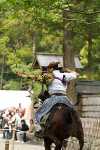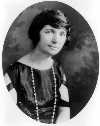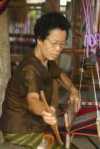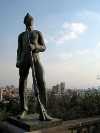 Described in Leo Tolstoy’s War and Peace, the Battle of Borodino was the largest and bloodiest single-day action of the Napoleonic Wars. An estimated 100,000 people died in the battle between the Russian forces of General Mikhail Kutuzov and Napoleon’s Grande Armée. After severely battering but not totally defeating the Russians, Napoleon’s forces marched the 70 miles (110 km) to Moscow and entered the city. As the population evacuated, fires engulfed much of the city. Who caused them? Discuss
Described in Leo Tolstoy’s War and Peace, the Battle of Borodino was the largest and bloodiest single-day action of the Napoleonic Wars. An estimated 100,000 people died in the battle between the Russian forces of General Mikhail Kutuzov and Napoleon’s Grande Armée. After severely battering but not totally defeating the Russians, Napoleon’s forces marched the 70 miles (110 km) to Moscow and entered the city. As the population evacuated, fires engulfed much of the city. Who caused them? Discuss
Source: The Free Dictionary
 This autumn festival in Japan, observed in the hope that it will bring a good harvest, provides an excellent display of traditional Japanese arts. There is a Shishi Odori dance, performed to the accompaniment of
This autumn festival in Japan, observed in the hope that it will bring a good harvest, provides an excellent display of traditional Japanese arts. There is a Shishi Odori dance, performed to the accompaniment of  Sanger married and had three children before becoming active in the women’s labor movement and the Socialist Party. Convinced that control over childbearing was the key to female emancipation, she published a pamphlet in 1914 in which she called for legalization of contraception and coined the term “birth control.” Founder of the organization that became Planned Parenthood, Sanger remains controversial for her views on contraception as well as race. Sanger was the sixth of how many children?
Sanger married and had three children before becoming active in the women’s labor movement and the Socialist Party. Convinced that control over childbearing was the key to female emancipation, she published a pamphlet in 1914 in which she called for legalization of contraception and coined the term “birth control.” Founder of the organization that became Planned Parenthood, Sanger remains controversial for her views on contraception as well as race. Sanger was the sixth of how many children?  According to legend, the secrets of sericulture and reeling from the cocoon were developed in China by 2640 BCE. By the 1st and 2nd centuries CE, silk fabrics were being imported to Rome and Greece and sold for exorbitant prices. Trade in silk became so prevalent that the ancient trade routes between China and the Mediterranean, spanning about 4,000 miles, have been dubbed the Silk Road. How did Mongols use silk as armor in battle?
According to legend, the secrets of sericulture and reeling from the cocoon were developed in China by 2640 BCE. By the 1st and 2nd centuries CE, silk fabrics were being imported to Rome and Greece and sold for exorbitant prices. Trade in silk became so prevalent that the ancient trade routes between China and the Mediterranean, spanning about 4,000 miles, have been dubbed the Silk Road. How did Mongols use silk as armor in battle?  Los Niños Héroes—the “Boy Heroes”—were six teenage Mexican army cadets who died defending Mexico City’s Chapultepec Castle from invading US forces during the Mexican-American War. Ignoring orders to fall back, the young cadets fought until the end. According to many accounts, the last survivor leapt from the castle roof wrapped in the Mexican flag to prevent it from being taken. What US President visited the monument honoring the cadets a few months before the battle’s 100th anniversary?
Los Niños Héroes—the “Boy Heroes”—were six teenage Mexican army cadets who died defending Mexico City’s Chapultepec Castle from invading US forces during the Mexican-American War. Ignoring orders to fall back, the young cadets fought until the end. According to many accounts, the last survivor leapt from the castle roof wrapped in the Mexican flag to prevent it from being taken. What US President visited the monument honoring the cadets a few months before the battle’s 100th anniversary?  A group of
A group of  After serving as apprentice to a Lancaster, Pennsylvania, confectioner, Hershey opened his own candy store in Philadelphia. By 1886, he was back in Lancaster, where he soon found success making caramels using fresh milk. By 1900, he had sold his caramel business to concentrate on chocolate. In 1903, he built a factory to manufacture five-cent chocolate bars, which became so popular that “Hershey” became virtually synonymous with chocolate in the US. To what causes did Hershey donate his fortune?
After serving as apprentice to a Lancaster, Pennsylvania, confectioner, Hershey opened his own candy store in Philadelphia. By 1886, he was back in Lancaster, where he soon found success making caramels using fresh milk. By 1900, he had sold his caramel business to concentrate on chocolate. In 1903, he built a factory to manufacture five-cent chocolate bars, which became so popular that “Hershey” became virtually synonymous with chocolate in the US. To what causes did Hershey donate his fortune?  The kite is an aircraft restrained by a towline that derives its lift from the aerodynamic action of the wind flowing across it. The apparatus consists of a stabilizing tail and light framework across which paper or thin material is stretched. It has been popular in China and East Asia for centuries. In the 18th century, Alexander Wilson used kites to obtain meteorological readings, and Benjamin Franklin used them to study lightning. Where is kite fighting a popular activity?
The kite is an aircraft restrained by a towline that derives its lift from the aerodynamic action of the wind flowing across it. The apparatus consists of a stabilizing tail and light framework across which paper or thin material is stretched. It has been popular in China and East Asia for centuries. In the 18th century, Alexander Wilson used kites to obtain meteorological readings, and Benjamin Franklin used them to study lightning. Where is kite fighting a popular activity?